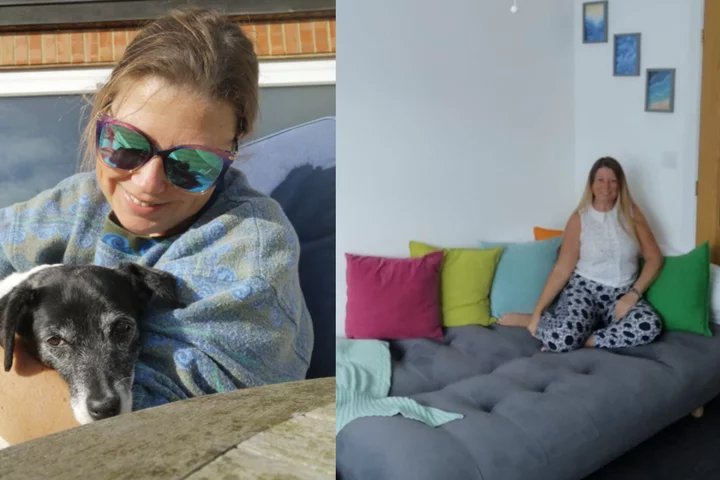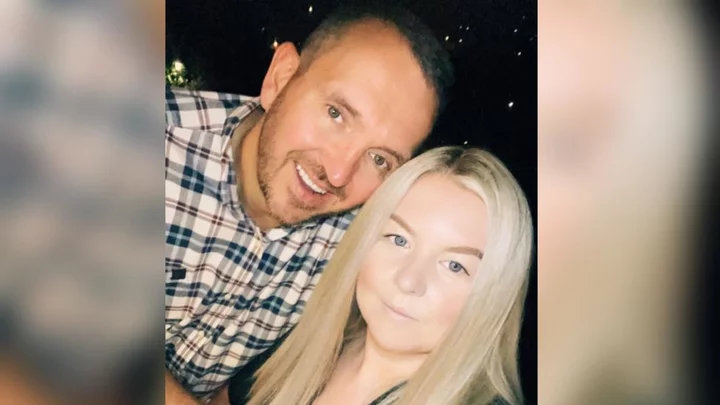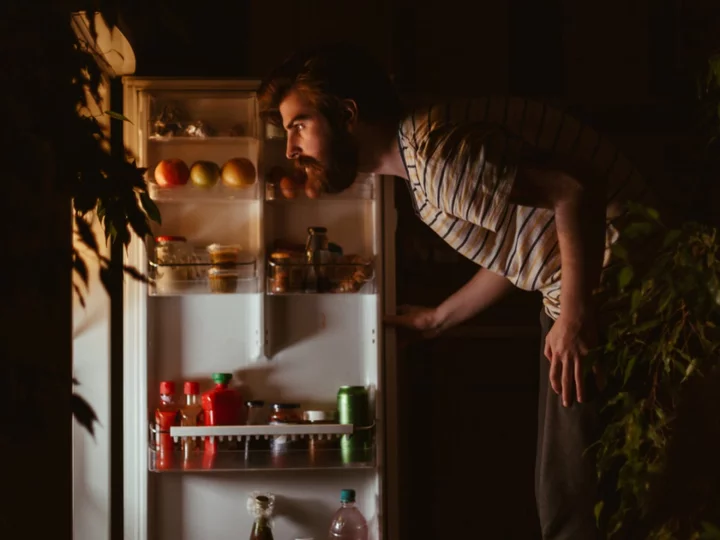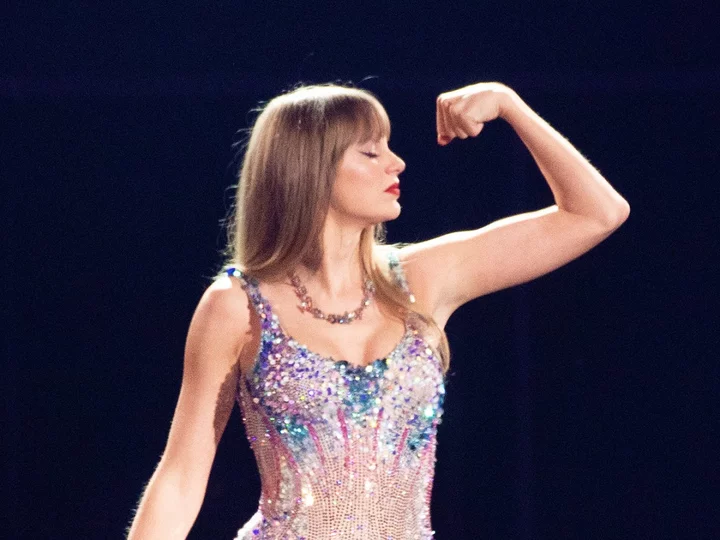
UFO Whistleblower Testimony Is Wild
UFC whistleblower David Grusch said some pretty crazy things in front of Congress.
2023-07-27 02:55

Ukraine MP under criminal investigation over Maldives holiday
Ukraine's security service is investigating whether he gave false information on leaving the country.
2023-07-27 01:57

NBA insider: Cavaliers should consider trading Donovan Mitchell
Are the Cleveland Cavaliers and Donovan Mitchell destined for an abrupt ending? One NBA insider thinks so.So far, the 2023 NBA off-season has been much quieter than 2022. By this time last year, a number of marquee trades had been swung, such as Rudy Gobert to the Timberwolves and Dejounte Murra...
2023-07-27 01:29

NBA insider explains real reason the Grizzlies were done with Dillon Brooks
An NBA insider discusses the real reason for Dillon Brooks' departure from the Memphis Grizzlies, and it has nothing to do with issues off the court.This offseason, Houston picked up Dillon Brooks on a four-year, $80 million sign-and-trade. Interestingly enough, Brooks was actually draftedb...
2023-07-27 01:25

Meet the former therapist making a living as a professional cuddler
A professional cuddler who makes a living giving clients hugs has said people travel from all over the globe to receive the cuddle therapy she offers which is “far less intimate than a massage” and helps people from “all walks of life”. Natasha Wicks, 44, from Coventry, West Midlands, says that despite criticism, cuddling is scientifically proven to release happy hormones like dopamine and that a lot of her clients are “the big spoon in life” and go to her for emotional support that they do not have at home. As such, many of her clients are caregivers and most of them join Natasha for two-hour hugging sessions, costing £70 an hour. The sessions vary depending on what the client wants, some having “emotional hugs”, others talking more and some wanting to “sit at opposite ends of the sofa with our legs and feet entwined”. Natasha became a cuddle therapist in 2015 and, while she has had comments online from people criticising the practice, she said that her family and friends were unsurprised when she first started giving professional cuddles. She said: “They all said to me that I give the best cuddles so it’s not surprising that I’d start doing it as a job. “It’s very much what I do, I help people and want to make people feel better. It’s a natural thing when someone is going through a tough time to want to give them a hug. “Cuddle therapy might not be as widely accepted in society but it’s far less intimate than other things like massages which are seen as normal.” Prior to becoming a cuddler, Natasha originally trained as a CBT therapist and counsellor. She said: “There’d be situations where I would be talking to someone and they’d really need a hug, but obviously, you’d have professional boundaries in place and it wouldn’t have been appropriate. “It was just a really natural thing. One client had finished her final session and we had agreed that she wasn’t my patient anymore so we hugged goodbye. She said to me that she’d wanted to do that for a long time and I thought ‘me too’.” Looking into cuddle therapy, which she said was increasing in popularity in 2014, Natasha took a training course. By 2015, she was a qualified cuddler and started taking on new patients for cuddle sessions. Natasha provides a minimum session of one hour but said most people go for at least two hours, sometimes longer if they are receiving more than one type of therapy. She said: “I always give people a hug on the doorstep when they arrive and then they’ll come in and relax, and we’ll have an initial chat about what brings them here. After that, I’ll put on some ambient music and we’ll have a cuddle on my cuddle sofa. “It can be daunting coming into a stranger’s house and I can tell the difference in them from arriving to leaving. The first hug they might be angled away from me but when we’re hugging goodbye, I can get my head in between their neck and shoulders and you can almost feel that a weight has been lifted from them.” There is not one type of person that visits Natasha for cuddles, but she says that a lot of her clients are caregivers. She said: “There’s all sorts of people who come for a cuddle, from people who have moved away from home for the first time and just want a mum hug all the way to people in their 80s. “I’m inclusive of all genders and all ages. I get a lot of clients who are the carers of their family and they are so busy looking after other people, and probably giving the hugs and support to other people, that they don’t have that for themselves. “A lot of people that come to see me are generally people are the big spoon in the life – they take care of others and don’t want to show a vulnerable side to people because they don’t want people to worry that they can’t cope. “I get a lot of carers, a lot of NHS staff, a lot of mums, a lot of people that are in a world where they have to be the strong one in the situation and they just want to be able to come here and let their guard down.” Natasha’s priority is to make people feel at ease when they arrive as she said it can be “nerve wracking” turning up at someone’s house for a hug. Setting out clear boundaries prior to meeting, the therapist has said that the patients she has welcomed into her home have all been respectful. She added: “I always say to people that when your body relaxes, your tummy might crumble and mine might too, but that people don’t need to worry about it. Sometimes people fall asleep and they might snore or fart, it’s just natural things that happen. It’s happened twice where someone has got an erection and that’s fine, I have boundaries and we’ll just change position. “I want people to feel reassured that, as soon as they get in, they feel comfortable.” Despite the unconventional therapy, when Natasha first took on cuddle clients, she said her family were completely “unsurprised” and the step from CBT therapy to cuddle therapy was a “natural evolution”. While Natasha focuses her time on a holistic approach for treating people, she noted that there is also neuroscience behind cuddles. According to the 44-year-old, physical touch activates the brain’s orbitofrontal cortex and cuddling releases oxytocin, dopamine and serotonin. Now, Natasha also does EMDR therapy and is a mental health swim host, and has clients travel from all over the globe to receive her hugs. She said: “Working from Coventry is brilliant because I’m only nine minutes on the train from Birmingham Airport and people come to visit me from all over. I get a client from Belgium, someone from Ireland and people from all over the UK who come to see me. “I wanted to find a sofa bed that just looked like a big comfy sofa for cuddle sessions. I’d started off with a big L shaped sofa but after about five years, it was sagging a bit, there’d been a lot of healing done on that sofa and it was time for a new one. “Now I have a sofa bed in my living room that I use as my cuddle sofa. It’s in the living room and it’s used for everyday life, watching TV with my partner, having people round and also for my work.” Breaking down the taboo around cuddle therapy, Natasha hopes more people will embrace the alternative treatment. She added: “As it’s become more popular, more people are becoming qualified as cuddlers and I think that’s great. “I’ve had comments online before of people thinking it’s weird or not understanding but there are other things we accept in society that are much more intimate than cuddles, like massages. “It’s not weird, it’s actually a really lovely thing to be able to make another soul feel better for a while.” Read More Charity boss speaks out over ‘traumatic’ encounter with royal aide Ukraine war’s heaviest fight rages in east - follow live Meet the professional cuddler charging £70-an-hour to hug ‘the big spoons in life’ New warnings about ‘concerning’ rise in at-home cosmetic dentistry What is ‘beer tanning’ and why are experts warning against it?
2023-07-26 22:45

Meet the professional cuddler charging £70-an-hour to hug ‘the big spoons in life’
A professional cuddler who makes a living giving clients hugs has said people travel from all over the globe to receive the cuddle therapy she offers which is “far less intimate than a massage” and helps people from “all walks of life”. Natasha Wicks, 44, from Coventry, West Midlands, says that despite criticism, cuddling is scientifically proven to release happy hormones like dopamine and that a lot of her clients are “the big spoon in life” and go to her for emotional support that they do not have at home. As such, many of her clients are caregivers and most of them join Natasha for two-hour hugging sessions, costing £70 an hour. The sessions vary depending on what the client wants, some having “emotional hugs”, others talking more and some wanting to “sit at opposite ends of the sofa with our legs and feet entwined”. Natasha became a cuddle therapist in 2015 and, while she has had comments online from people criticising the practice, she said that her family and friends were unsurprised when she first started giving professional cuddles. She said: “They all said to me that I give the best cuddles so it’s not surprising that I’d start doing it as a job. “It’s very much what I do, I help people and want to make people feel better. It’s a natural thing when someone is going through a tough time to want to give them a hug. “Cuddle therapy might not be as widely accepted in society but it’s far less intimate than other things like massages which are seen as normal.” Prior to becoming a cuddler, Natasha originally trained as a CBT therapist and counsellor. She said: “There’d be situations where I would be talking to someone and they’d really need a hug, but obviously, you’d have professional boundaries in place and it wouldn’t have been appropriate. “It was just a really natural thing. One client had finished her final session and we had agreed that she wasn’t my patient anymore so we hugged goodbye. She said to me that she’d wanted to do that for a long time and I thought ‘me too’.” Looking into cuddle therapy, which she said was increasing in popularity in 2014, Natasha took a training course. By 2015, she was a qualified cuddler and started taking on new patients for cuddle sessions. Natasha provides a minimum session of one hour but said most people go for at least two hours, sometimes longer if they are receiving more than one type of therapy. She said: “I always give people a hug on the doorstep when they arrive and then they’ll come in and relax, and we’ll have an initial chat about what brings them here. After that, I’ll put on some ambient music and we’ll have a cuddle on my cuddle sofa. “It can be daunting coming into a stranger’s house and I can tell the difference in them from arriving to leaving. The first hug they might be angled away from me but when we’re hugging goodbye, I can get my head in between their neck and shoulders and you can almost feel that a weight has been lifted from them.” There is not one type of person that visits Natasha for cuddles, but she says that a lot of her clients are caregivers. She said: “There’s all sorts of people who come for a cuddle, from people who have moved away from home for the first time and just want a mum hug all the way to people in their 80s. “I’m inclusive of all genders and all ages. I get a lot of clients who are the carers of their family and they are so busy looking after other people, and probably giving the hugs and support to other people, that they don’t have that for themselves. “A lot of people that come to see me are generally people are the big spoon in the life – they take care of others and don’t want to show a vulnerable side to people because they don’t want people to worry that they can’t cope. “I get a lot of carers, a lot of NHS staff, a lot of mums, a lot of people that are in a world where they have to be the strong one in the situation and they just want to be able to come here and let their guard down.” Natasha’s priority is to make people feel at ease when they arrive as she said it can be “nerve wracking” turning up at someone’s house for a hug. Setting out clear boundaries prior to meeting, the therapist has said that the patients she has welcomed into her home have all been respectful. She added: “I always say to people that when your body relaxes, your tummy might crumble and mine might too, but that people don’t need to worry about it. Sometimes people fall asleep and they might snore or fart, it’s just natural things that happen. It’s happened twice where someone has got an erection and that’s fine, I have boundaries and we’ll just change position. “I want people to feel reassured that, as soon as they get in, they feel comfortable.” Despite the unconventional therapy, when Natasha first took on cuddle clients, she said her family were completely “unsurprised” and the step from CBT therapy to cuddle therapy was a “natural evolution”. While Natasha focuses her time on a holistic approach for treating people, she noted that there is also neuroscience behind cuddles. According to the 44-year-old, physical touch activates the brain’s orbitofrontal cortex and cuddling releases oxytocin, dopamine and serotonin. Now, Natasha also does EMDR therapy and is a mental health swim host, and has clients travel from all over the globe to receive her hugs. She said: “Working from Coventry is brilliant because I’m only nine minutes on the train from Birmingham Airport and people come to visit me from all over. I get a client from Belgium, someone from Ireland and people from all over the UK who come to see me. “I wanted to find a sofa bed that just looked like a big comfy sofa for cuddle sessions. I’d started off with a big L shaped sofa but after about five years, it was sagging a bit, there’d been a lot of healing done on that sofa and it was time for a new one. “Now I have a sofa bed in my living room that I use as my cuddle sofa. It’s in the living room and it’s used for everyday life, watching TV with my partner, having people round and also for my work.” Breaking down the taboo around cuddle therapy, Natasha hopes more people will embrace the alternative treatment. She added: “As it’s become more popular, more people are becoming qualified as cuddlers and I think that’s great. “I’ve had comments online before of people thinking it’s weird or not understanding but there are other things we accept in society that are much more intimate than cuddles, like massages. “It’s not weird, it’s actually a really lovely thing to be able to make another soul feel better for a while.” Read More Charity boss speaks out over ‘traumatic’ encounter with royal aide Ukraine war’s heaviest fight rages in east - follow live New warnings about ‘concerning’ rise in at-home cosmetic dentistry What is ‘beer tanning’ and why are experts warning against it? Christian Cowan: Designing is like dreaming
2023-07-26 22:45

MLB Rumors: Yankees-Phillies trade showdown, Mariners swoop, India goes to Seattle
MLB Rumors: Could Mariners steal a top trade target from Yankees?The New York Yankees' interest in Cubs star Cody Bellinger is already well-documented. With Chicago looking more and more like sellers at the deadline, Bellinger stands out as one of the most desirable sluggers ready to be dealt...
2023-07-26 07:53

Rhodes honeymoon 'wrecked' after hotel evacuation
The couple from Stoke-on-Trent said their holiday had been a "rollercoaster".
2023-07-25 19:45

Late night snacking could increase risk of diabetes and heart disease, study says
Eating a snack late at night carries significantly more negative health implications compared to snacking during the day, a new study has found. According to researchers at King’s College London, people who eat most of their snacks in the evening after 9pm saw larger spikes in their blood sugar compared to those snacked earlier in the day. The group who snacked later also had higher concentrations of fat in their blood compared to those who snacked earlier. The researchers studied data from 1,000 people who took part in the Zoe Predict study. The participants kept a food diary and wore blood sugar monitors in order to keep track of the impact of snacking. On average, they ate two snacks a day, with one in three “late evening snackers” eating most of their snacks after 9pm instead of between meals. High blood sugar and fat can lead to diabetes and heart disease, studies have found. People with diabetes are also more likely to have other conditions that raise the risk of heart disease, such as high blood pressure. The Zoe Predict project is a group of in-depth nutritional research studies that aim to reveal how and why people respond differently to the same foods. Kate Bermingham, a postdoctoral fellow at King’s College London and lead author of the study, said: “Surprisingly little has been published on snacking, despite the fact that it accounts for 20 to 25 per cent of energy intake. “Predict followed a large number of people and captured detailed information on their snacking behaviours, allowing this in-depth exploration of snacking on health.” Researchers analysed the relationship between the number of snacks participants ate, the quality of the snacks and the timing with blood fats and insulin levels. Snacking on higher quality foods, which are described as foods that contain significant amounts of nutrients relative to the calories contained, was associated with better bodily responses. The study concluded that the most important factor in determining the body’s response is the quality of snacks, not how often or how much they are consumed. Foods like fruit or vegetables resulted in a better blood fat and insulin response compared to processed foods, such as biscuits and cake. Bermingham added: “Our study showed that the quality of snacking is more important than the quantity or frequency of snacking, thus choosing high quality snacks over the highly processed snacks is likely beneficial. “Timing is also important, with late night snacking being unfavourable for health. This may mean that, universally, snacking late in the evening and interrupting the overnight fasting window is detrimental to health.” The study was presented at a meeting of the American Society for Nutrition. Read More My Taylor Swift exercise class has led me down a luxury fitness rabbit hole Husband fired from family business after wife roleplayed with reborn dolls MrBeast YouTuber Kris Tyson comes out as transgender: ‘I’m excited to authentically be myself’ Scientists share the 8 habits that impact your lifespan the most Cara Delevingne says her journey to sobriety has been worth ‘every second/ Bisexual people ‘experience worse health than other adults’
2023-07-25 18:50

My Taylor Swift exercise class has led me down a luxury fitness rabbit hole
Amid flashing strobe lights at a SoulCycle class in Notting Hill, our instructor MJ stands on a platform, his baseball cap flipped backward and his facial hair trimmed into designer stubble, looking as if he’s straight out of a boy band. “I’ve had a f***ing s*** day and I didn’t want to come to work,” he says, softly, through his head mic. “But I’m so glad I did, as the energy is bringing me to life!” Everyone around me – women between the ages of 25 and 35, all of them dressed in one-shoulder leisurewear – roars in response. “Sit up tall, don’t let anyone make you feel down,” MJ continues. “You’re all legends, don’t let anybody judge you!” I pause for breath after yet another manic burst of energy cycling on the spot. Then we have to pick up dumbbells while atop stationary bikes and do a choreographed workout to a Taylor Swift song. This special Swift-themed class is taking place at 8.30 on a Monday night and in the same venue where First Lady Jill Biden and Rishi Sunak’s wife Akshata Murty attended a spinning class together after King Charles’s coronation in May – reportedly with 10 security guards in tow. I feel slightly out of my depth. I spent two hours looking for my lycra leggings and I’m totally unfit. Apart from walking my dog, I haven’t done any real exercise since 2017, when I had a go at clean eating and did a few weeks of high-intensity training at the gym. But now I’m ready for SoulCycle’s “unique mind-body-soul experience”. This leap back into exercise is partly inspired by Apple TV+’s dark comedy Physical, which is returning for its final season next month. It’s about a housewife played by Rose Byrne who battles her demons and a vicious and self-critical inner voice while finding solace in aerobics. Could it work for me, too? Is exercise the answer to my endlessly spinning mind? Would it serve as an instant catapult into a world of empowerment and success? Everyone in this class knows the words to every Taylor Swift song that booms from the speakers. “Drop everything now/Meet me in the pouring rain”, she sings on “Sparks Fly”. “Kiss me on the sidewalk/Take away the pain.” But all I can think about is the pain I’m currently in. We’re wearing special shoes that click into the pedals of the bike, so it’s not easy to detach oneself. But soon I become grateful for it: if I’m superglued into this class, I can’t give up so easily. As MJ says: “No struggle... no progress”. It doesn’t matter if you can’t move the wheel at the front of the SoulCycle bike, or if you’re peddling down on it like a gazelle; if you’re sweating and panting, you’re part of this love-in. And wow, it feels great. I’m not alone in adoring it, and some of my fellow riders were here even earlier, for “part one” of a class modelled after Swift’s setlist on her current US tour. (Each class costs £26, while a renewable package of four is £86, or eight at £160). It’s a little pocket of joy I knew nothing about while I was sitting at home snacking in front of my laptop and gaining weight. As I leave the SoulCycle studio and wander into the night, I take a deep breath. It feels good to be back in the saddle – even though my legs are like jelly. I have to ask my friend to drive me home because I’m not sure I’ll make it on foot. There are a few reasons I haven’t been hitting the gym, or even doing the occasional relaxed yoga class. Having children on my own has been an intense journey. For years my idea of exercise has been holding a baby or running after two kids in a park with an unruly dog. But when I read a few different headlines lately (“Fit and fabulous at 54: Jennifer Aniston emerges from her new workout class”; “Nicole Kidman, 56, flashes her incredible abs in revealing black dress”), I felt a pang of guilt. These women are older than me but super fit. My daughters, aged five and seven, are both at school now, so there’s no excuse for being so inactive. I had some blood tests done and my cholesterol is creeping up. I’ve been told I need to give up sugar and take up exercise. How can I be a good role model to my kids if all they do is see me eating the chocolate rolls meant for their pack lunches? And where do I even begin with fitness? After the excitement of my Taylor Swift class, the idea of strolling along to my local Virgin Active feels mundane. I ponder whether it’d be easier to stay fit if I was super-rich. I can see myself signing up for four workout sessions rigged up to an electrical current. Because why not? I can’t possibly afford the bespoke, members-only gym Bodyism in London’s Westbourne Grove, whose clients include heiress Tamara Ecclestone. It caters for high-intensity, low-impact training, with top-tier packages costing £23,000 a year. More affordable, though, is their class membership – which costs £1,500 a year for 72 classes and promises to help elongate and tone the body. But it’s also full of the clean-eating squad – I might not fit in. Then there’s London’s BXR, a private, boutique boxing-themed gym that’s spread over two floors. From the street below I can glimpse a massive boxing ring behind enormous glass panels – a manifestation of the idea that celebrities feel they live in a goldfish bowl. It’s also packed with A-listers who get free guest passes while staying at the luxury hotel Chiltern Firehouse that’s located opposite. Membership costs from £2,500 a year and up (by a lot), and the Vogue editor Edward Enniful and fashion designer Julian Macdonald are apparently fans of BXR’s Versaclimbing – a high-intensity, low-impact workout on a Versaclimber. This cardio fitness machine has a 75-degree vertical rail with pedals and handles that mimic the natural motion of climbing. When I hear that the machine burns up to 800 calories in a 45-minute session – well, I’m on the phone to the bookings team in a flash. Unlike treadmill or spin classes, it’s exercise that is full body but low impact – meaning it “minimises unnecessary stress or trauma to your body”. At the state of the art Repose, a wellness clinic in London’s High Street Kensington with members including Made in Chelsea’s Millie Mackintosh, the speciality is “anti-gravity fitness”. It might sound unusual to exercise from a silk hammock suspended from the ceiling for £40 a class – but sessions include pilates, suspension fitness, air bar and both restorative and aerial yoga. Models and celebrities, including Poppy Delevingne, are also queuing up for personal training at London’s E-Pulsive, which costs £85 a session. The electrical muscle stimulation class (EMS) sees you strap yourself into a full-body vest that zaps you with low-frequency electric impulses to manually contract your muscle fibres while you exercise, increasing the intensity of your workout. It seems ideal for people like me who are too busy to exercise but who want superfast results – apparently, a 20-minute EMS workout burns 500 calories and can offer the same results as a 90-minute high-intensity gym class. It sounds like heaven. Then there’s roller-skating at model Liberty Ross’ glamorous Flipper’s Roller Boogie Palace in West London or New York – the original LA Flipper’s in the 1970s was run by Ross’s dad Ian Flipper-Ross, and was so associated with glam fitness that it was dubbed “Studio 54 on wheels”. A one-to-one beginner’s class at the new skate school costs £50, or £35 in a group lesson of up to 12 skaters. Or you can just book in for a general skate with your kids – which kills two birds with one stone as they have fun while you burn calories. A two-hour skate session for adults starts from £15.50 and from £11.50 for children. All of this sounds great – but if I went for a workout schedule of my choice, I can’t see it totalling less than £30,000 a year. Bearing in mind that exercise is addictive and makes you feel good, it might be far more in the long run, too. It’s also a tad out of my price range – I don’t plan on dropping into Equinox on Kensington Roof Gardens or the Bulgari Hotel gym any time soon. Instead, I can see myself signing up for four workout sessions rigged up to an electrical current. Because why not? If money wasn’t an obstacle, I would install a gym and a pilates studio in my own house, with a cryotherapy chamber and a personal trainer on tap. But until then, I plan to start running with the dog, my two kids behind me on their scooters. It’s far cheaper and – unlike the late-night Taylor Swift class – won’t require a babysitter. Read More I keep forgetting my dog’s birthday – could a luxury pet party make it up to him? ‘I’m here anyway, why not?’: My non-surgical facelift has got me thinking about more procedures I’ve never had a platonic relationship with a man – sex can’t help but get in the way Husband fired from family business after wife roleplayed with reborn dolls Montana Brown explains why she chose a home birth as a ‘non-white person’ 8 healthy habits to help you live longer – according to a new study
2023-07-25 13:53

Trea Turner’s rough season goes from bad to worse
Trea Turner has not been what the Phillies hoped he'd be this year. His frustration boiled over on Monday with boos and an ejection.Trea Turner signed an 11-year contract worth $300 million with the Phillies. Year 1 has not gone well.The shortstop is batting a disappointing .249/.302/.3...
2023-07-25 11:29

X X's More X Than Twitter
Twitter's name change is a XXXXing embarrassment.
2023-07-25 02:23
